Sabanci Foundation's Philanthropic Role in Shaping Education Policy
VerifiedAdded on 2023/06/10
|19
|5292
|101
Essay
AI Summary
This essay explores the role of philanthropy in shaping education policy, focusing on the Sabanci Foundation's activities in Turkey. It examines the historical development of philanthropy, contrasting traditional approaches with philanthrocapitalism. The essay analyzes how the Sabanci Foundation, one of Turkey's largest family foundations, has evolved its philanthropic strategies since 1974, particularly in the field of education. It discusses the foundation's efforts to address inequality and support public service delivery, while also considering the debates surrounding philanthrocapitalism and its potential top-down approach. The study concludes by highlighting the Sabanci Foundation's significant contributions to overcoming societal inequalities through its educational philanthropy.
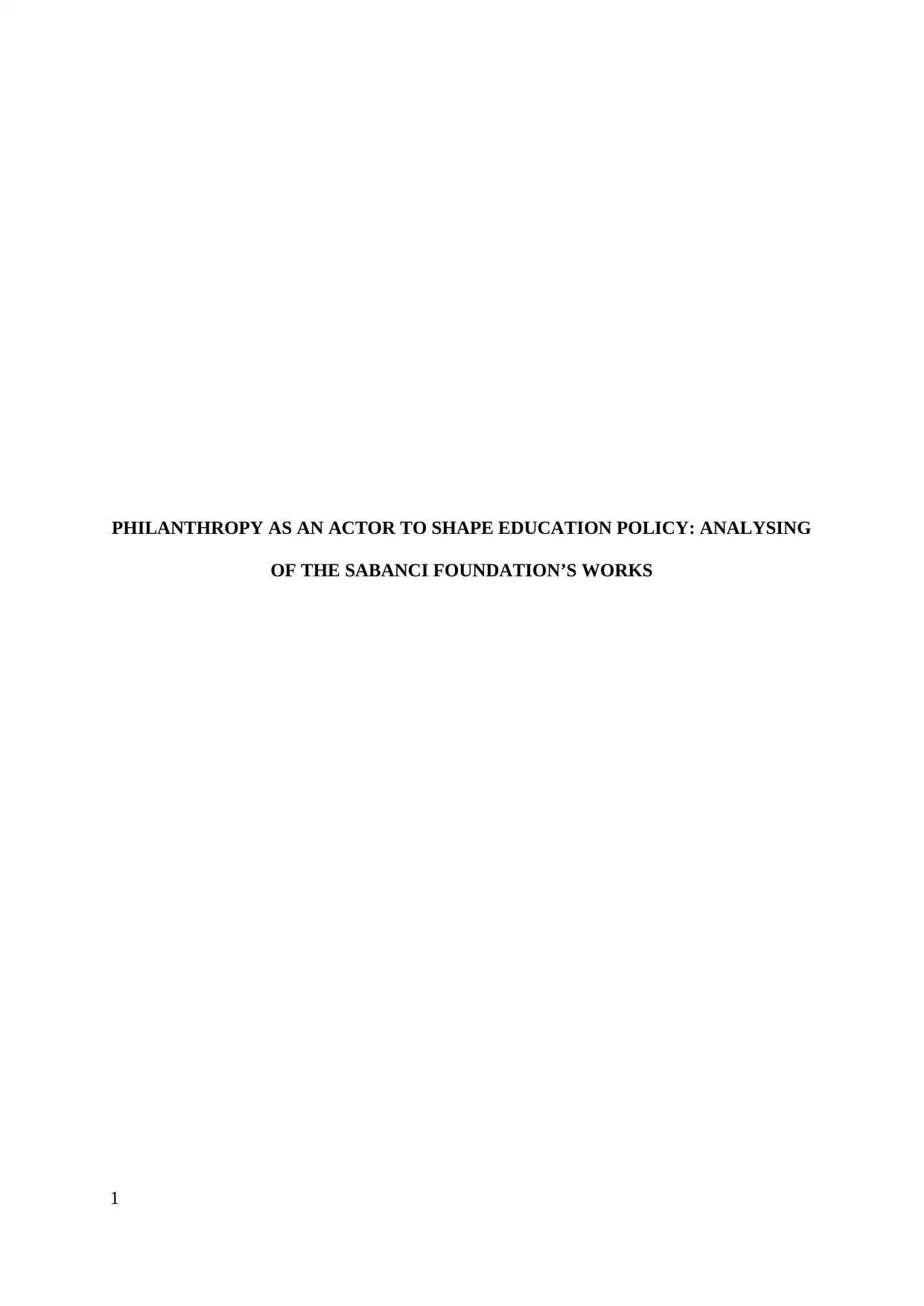
PHILANTHROPY AS AN ACTOR TO SHAPE EDUCATION POLICY: ANALYSING
OF THE SABANCI FOUNDATION’S WORKS
1
OF THE SABANCI FOUNDATION’S WORKS
1
Paraphrase This Document
Need a fresh take? Get an instant paraphrase of this document with our AI Paraphraser
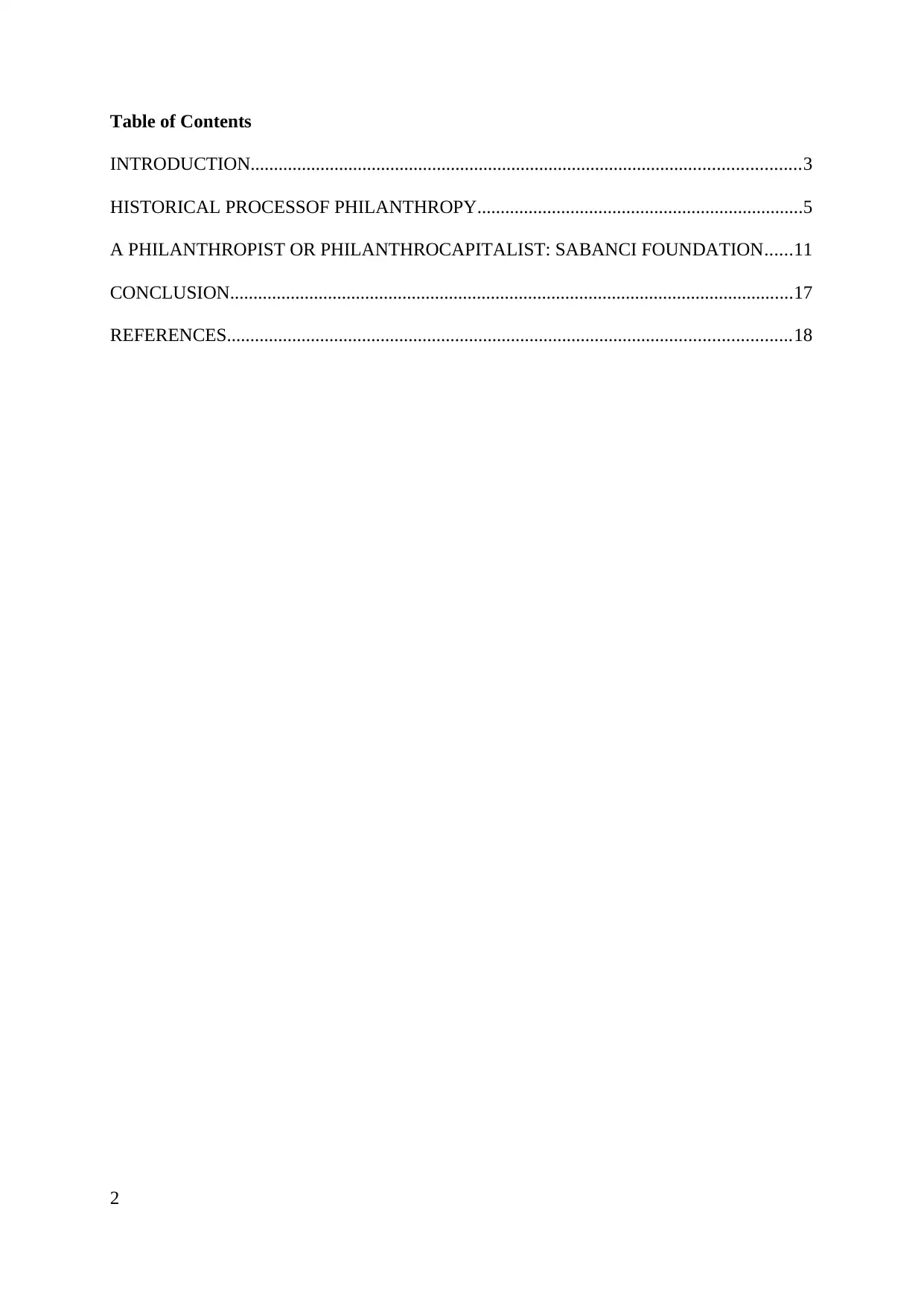
Table of Contents
INTRODUCTION......................................................................................................................3
HISTORICAL PROCESSOF PHILANTHROPY......................................................................5
A PHILANTHROPIST OR PHILANTHROCAPITALIST: SABANCI FOUNDATION......11
CONCLUSION.........................................................................................................................17
REFERENCES.........................................................................................................................18
2
INTRODUCTION......................................................................................................................3
HISTORICAL PROCESSOF PHILANTHROPY......................................................................5
A PHILANTHROPIST OR PHILANTHROCAPITALIST: SABANCI FOUNDATION......11
CONCLUSION.........................................................................................................................17
REFERENCES.........................................................................................................................18
2
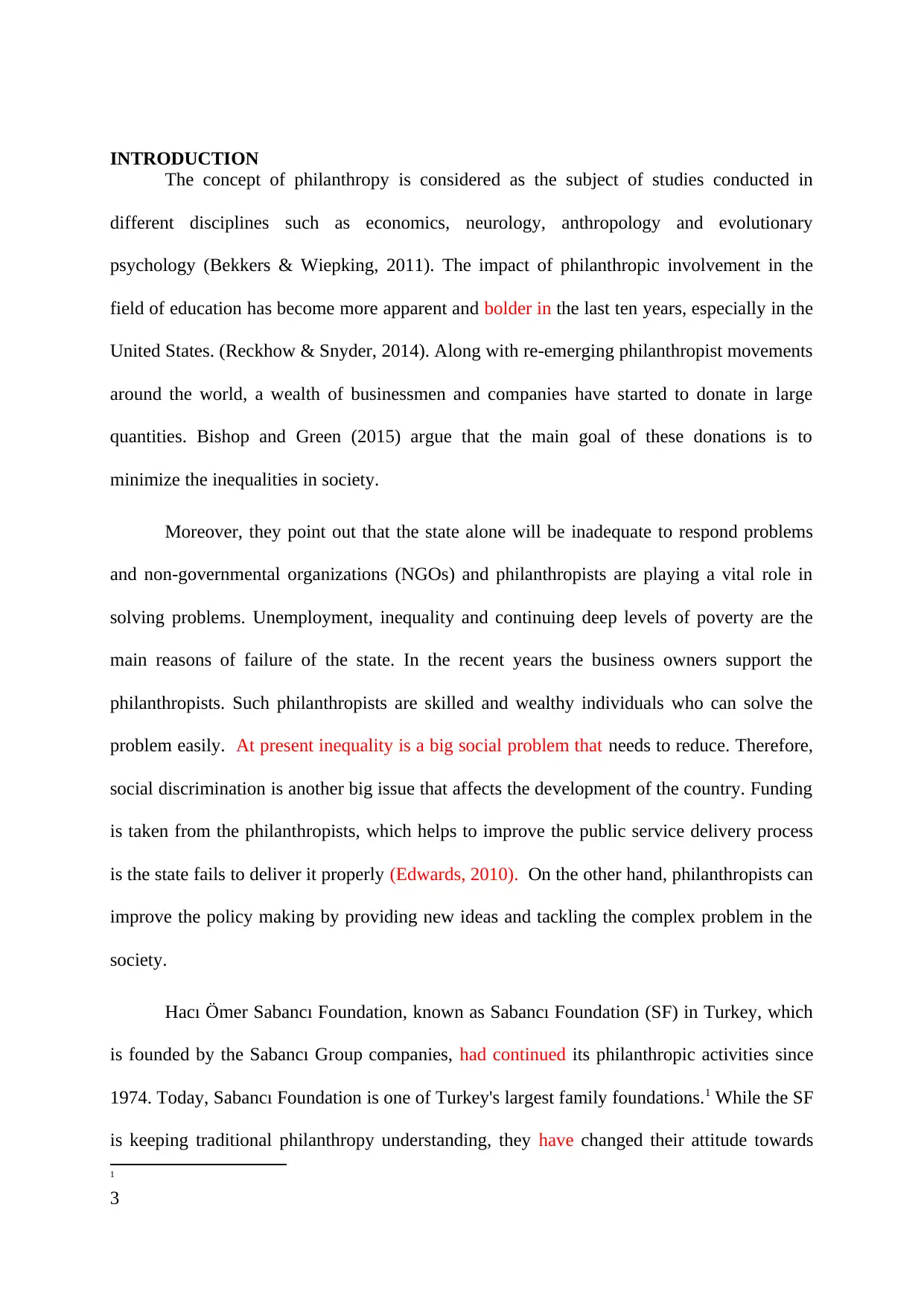
INTRODUCTION
The concept of philanthropy is considered as the subject of studies conducted in
different disciplines such as economics, neurology, anthropology and evolutionary
psychology (Bekkers & Wiepking, 2011). The impact of philanthropic involvement in the
field of education has become more apparent and bolder in the last ten years, especially in the
United States. (Reckhow & Snyder, 2014). Along with re-emerging philanthropist movements
around the world, a wealth of businessmen and companies have started to donate in large
quantities. Bishop and Green (2015) argue that the main goal of these donations is to
minimize the inequalities in society.
Moreover, they point out that the state alone will be inadequate to respond problems
and non-governmental organizations (NGOs) and philanthropists are playing a vital role in
solving problems. Unemployment, inequality and continuing deep levels of poverty are the
main reasons of failure of the state. In the recent years the business owners support the
philanthropists. Such philanthropists are skilled and wealthy individuals who can solve the
problem easily. At present inequality is a big social problem that needs to reduce. Therefore,
social discrimination is another big issue that affects the development of the country. Funding
is taken from the philanthropists, which helps to improve the public service delivery process
is the state fails to deliver it properly (Edwards, 2010). On the other hand, philanthropists can
improve the policy making by providing new ideas and tackling the complex problem in the
society.
Hacı Ömer Sabancı Foundation, known as Sabancı Foundation (SF) in Turkey, which
is founded by the Sabancı Group companies, had continued its philanthropic activities since
1974. Today, Sabancı Foundation is one of Turkey's largest family foundations.1 While the SF
is keeping traditional philanthropy understanding, they have changed their attitude towards
1
3
The concept of philanthropy is considered as the subject of studies conducted in
different disciplines such as economics, neurology, anthropology and evolutionary
psychology (Bekkers & Wiepking, 2011). The impact of philanthropic involvement in the
field of education has become more apparent and bolder in the last ten years, especially in the
United States. (Reckhow & Snyder, 2014). Along with re-emerging philanthropist movements
around the world, a wealth of businessmen and companies have started to donate in large
quantities. Bishop and Green (2015) argue that the main goal of these donations is to
minimize the inequalities in society.
Moreover, they point out that the state alone will be inadequate to respond problems
and non-governmental organizations (NGOs) and philanthropists are playing a vital role in
solving problems. Unemployment, inequality and continuing deep levels of poverty are the
main reasons of failure of the state. In the recent years the business owners support the
philanthropists. Such philanthropists are skilled and wealthy individuals who can solve the
problem easily. At present inequality is a big social problem that needs to reduce. Therefore,
social discrimination is another big issue that affects the development of the country. Funding
is taken from the philanthropists, which helps to improve the public service delivery process
is the state fails to deliver it properly (Edwards, 2010). On the other hand, philanthropists can
improve the policy making by providing new ideas and tackling the complex problem in the
society.
Hacı Ömer Sabancı Foundation, known as Sabancı Foundation (SF) in Turkey, which
is founded by the Sabancı Group companies, had continued its philanthropic activities since
1974. Today, Sabancı Foundation is one of Turkey's largest family foundations.1 While the SF
is keeping traditional philanthropy understanding, they have changed their attitude towards
1
3
⊘ This is a preview!⊘
Do you want full access?
Subscribe today to unlock all pages.

Trusted by 1+ million students worldwide
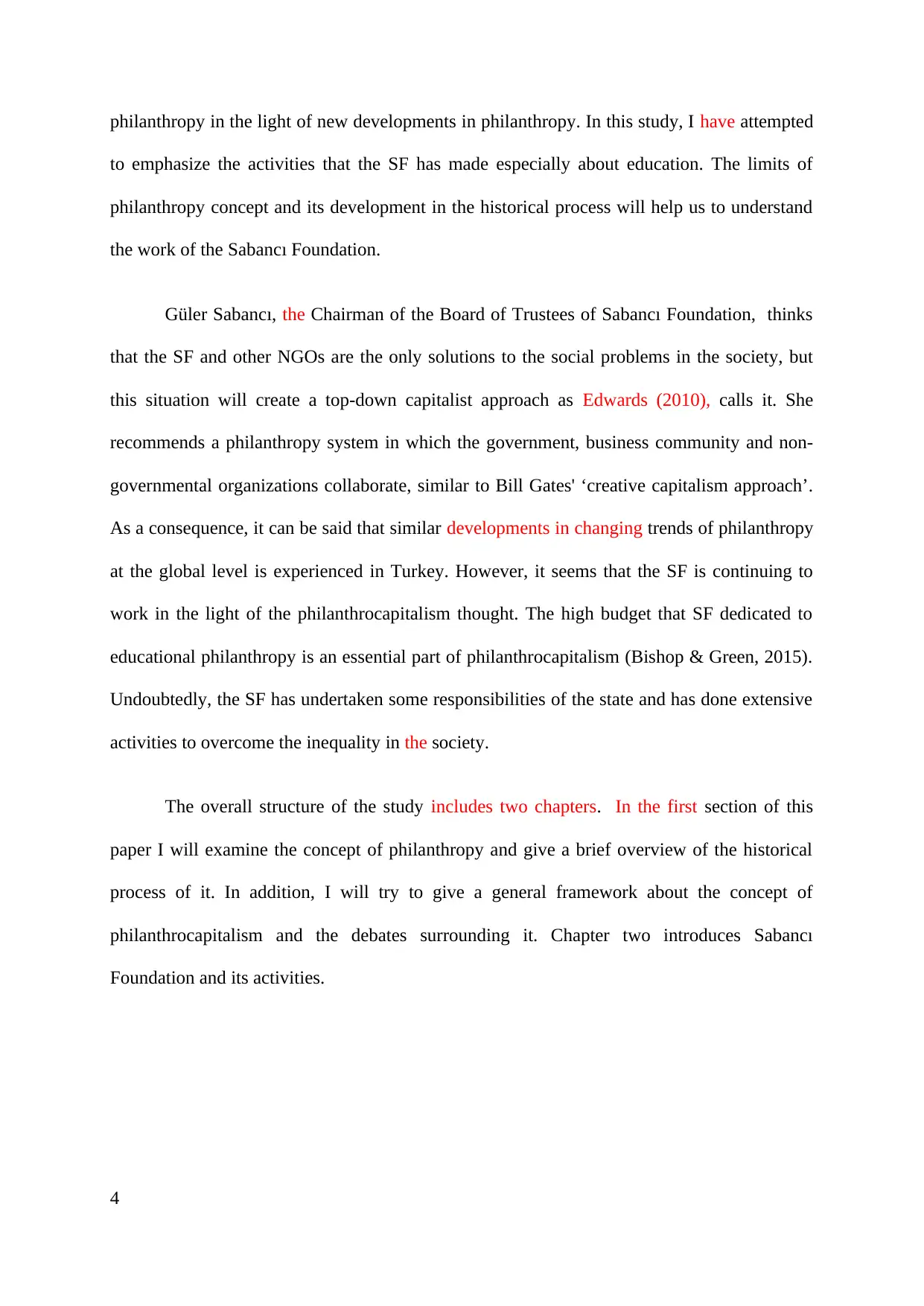
philanthropy in the light of new developments in philanthropy. In this study, I have attempted
to emphasize the activities that the SF has made especially about education. The limits of
philanthropy concept and its development in the historical process will help us to understand
the work of the Sabancı Foundation.
Güler Sabancı, the Chairman of the Board of Trustees of Sabancı Foundation, thinks
that the SF and other NGOs are the only solutions to the social problems in the society, but
this situation will create a top-down capitalist approach as Edwards (2010), calls it. She
recommends a philanthropy system in which the government, business community and non-
governmental organizations collaborate, similar to Bill Gates' ‘creative capitalism approach’.
As a consequence, it can be said that similar developments in changing trends of philanthropy
at the global level is experienced in Turkey. However, it seems that the SF is continuing to
work in the light of the philanthrocapitalism thought. The high budget that SF dedicated to
educational philanthropy is an essential part of philanthrocapitalism (Bishop & Green, 2015).
Undoubtedly, the SF has undertaken some responsibilities of the state and has done extensive
activities to overcome the inequality in the society.
The overall structure of the study includes two chapters. In the first section of this
paper I will examine the concept of philanthropy and give a brief overview of the historical
process of it. In addition, I will try to give a general framework about the concept of
philanthrocapitalism and the debates surrounding it. Chapter two introduces Sabancı
Foundation and its activities.
4
to emphasize the activities that the SF has made especially about education. The limits of
philanthropy concept and its development in the historical process will help us to understand
the work of the Sabancı Foundation.
Güler Sabancı, the Chairman of the Board of Trustees of Sabancı Foundation, thinks
that the SF and other NGOs are the only solutions to the social problems in the society, but
this situation will create a top-down capitalist approach as Edwards (2010), calls it. She
recommends a philanthropy system in which the government, business community and non-
governmental organizations collaborate, similar to Bill Gates' ‘creative capitalism approach’.
As a consequence, it can be said that similar developments in changing trends of philanthropy
at the global level is experienced in Turkey. However, it seems that the SF is continuing to
work in the light of the philanthrocapitalism thought. The high budget that SF dedicated to
educational philanthropy is an essential part of philanthrocapitalism (Bishop & Green, 2015).
Undoubtedly, the SF has undertaken some responsibilities of the state and has done extensive
activities to overcome the inequality in the society.
The overall structure of the study includes two chapters. In the first section of this
paper I will examine the concept of philanthropy and give a brief overview of the historical
process of it. In addition, I will try to give a general framework about the concept of
philanthrocapitalism and the debates surrounding it. Chapter two introduces Sabancı
Foundation and its activities.
4
Paraphrase This Document
Need a fresh take? Get an instant paraphrase of this document with our AI Paraphraser
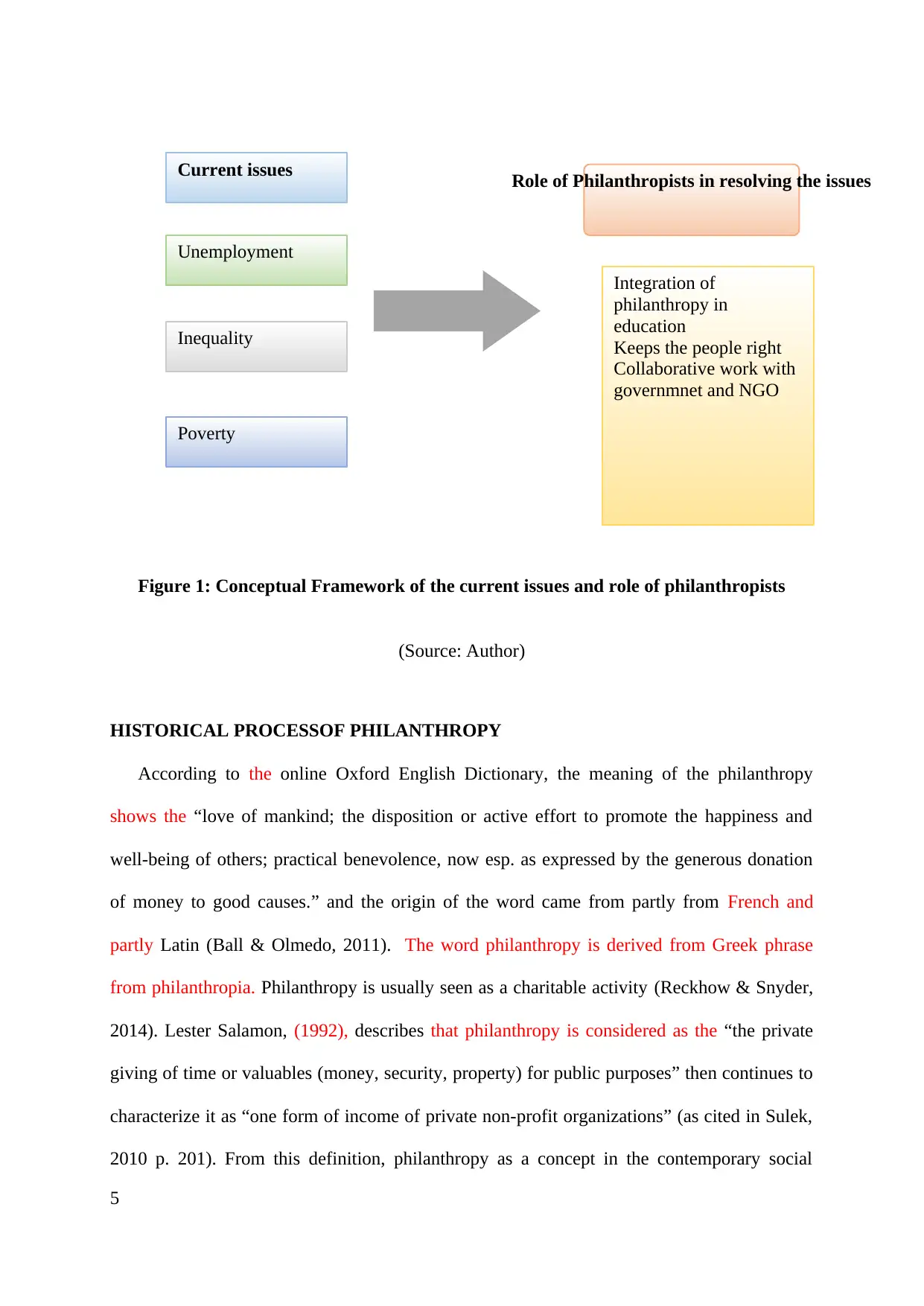
Current issues
Unemployment
Inequality
Poverty
Role of Philanthropists in resolving the issues
Integration of
philanthropy in
education
Keeps the people right
Collaborative work with
governmnet and NGO
Figure 1: Conceptual Framework of the current issues and role of philanthropists
(Source: Author)
HISTORICAL PROCESSOF PHILANTHROPY
According to the online Oxford English Dictionary, the meaning of the philanthropy
shows the “love of mankind; the disposition or active effort to promote the happiness and
well-being of others; practical benevolence, now esp. as expressed by the generous donation
of money to good causes.” and the origin of the word came from partly from French and
partly Latin (Ball & Olmedo, 2011). The word philanthropy is derived from Greek phrase
from philanthropia. Philanthropy is usually seen as a charitable activity (Reckhow & Snyder,
2014). Lester Salamon, (1992), describes that philanthropy is considered as the “the private
giving of time or valuables (money, security, property) for public purposes” then continues to
characterize it as “one form of income of private non-profit organizations” (as cited in Sulek,
2010 p. 201). From this definition, philanthropy as a concept in the contemporary social
5
Unemployment
Inequality
Poverty
Role of Philanthropists in resolving the issues
Integration of
philanthropy in
education
Keeps the people right
Collaborative work with
governmnet and NGO
Figure 1: Conceptual Framework of the current issues and role of philanthropists
(Source: Author)
HISTORICAL PROCESSOF PHILANTHROPY
According to the online Oxford English Dictionary, the meaning of the philanthropy
shows the “love of mankind; the disposition or active effort to promote the happiness and
well-being of others; practical benevolence, now esp. as expressed by the generous donation
of money to good causes.” and the origin of the word came from partly from French and
partly Latin (Ball & Olmedo, 2011). The word philanthropy is derived from Greek phrase
from philanthropia. Philanthropy is usually seen as a charitable activity (Reckhow & Snyder,
2014). Lester Salamon, (1992), describes that philanthropy is considered as the “the private
giving of time or valuables (money, security, property) for public purposes” then continues to
characterize it as “one form of income of private non-profit organizations” (as cited in Sulek,
2010 p. 201). From this definition, philanthropy as a concept in the contemporary social
5
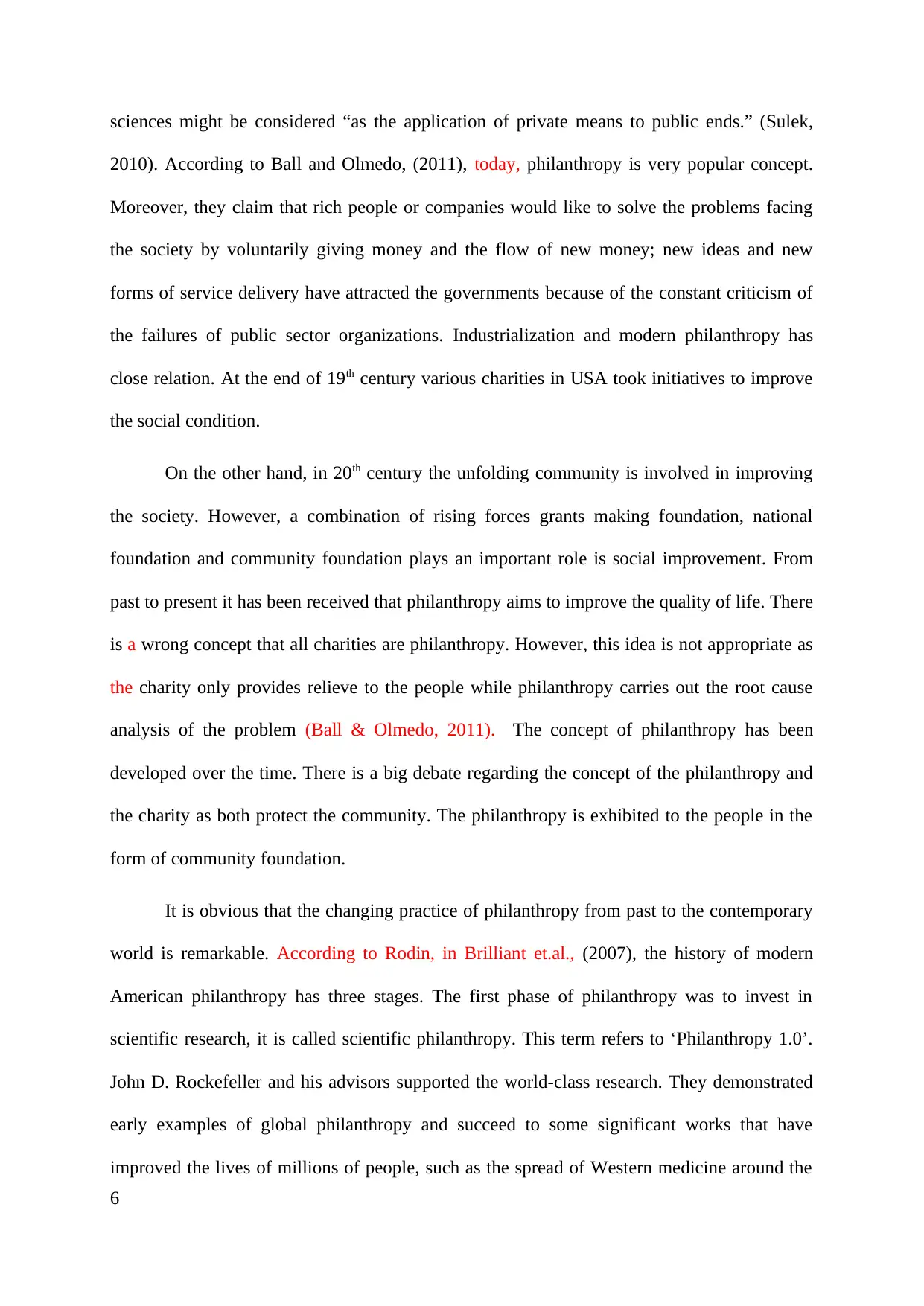
sciences might be considered “as the application of private means to public ends.” (Sulek,
2010). According to Ball and Olmedo, (2011), today, philanthropy is very popular concept.
Moreover, they claim that rich people or companies would like to solve the problems facing
the society by voluntarily giving money and the flow of new money; new ideas and new
forms of service delivery have attracted the governments because of the constant criticism of
the failures of public sector organizations. Industrialization and modern philanthropy has
close relation. At the end of 19th century various charities in USA took initiatives to improve
the social condition.
On the other hand, in 20th century the unfolding community is involved in improving
the society. However, a combination of rising forces grants making foundation, national
foundation and community foundation plays an important role is social improvement. From
past to present it has been received that philanthropy aims to improve the quality of life. There
is a wrong concept that all charities are philanthropy. However, this idea is not appropriate as
the charity only provides relieve to the people while philanthropy carries out the root cause
analysis of the problem (Ball & Olmedo, 2011). The concept of philanthropy has been
developed over the time. There is a big debate regarding the concept of the philanthropy and
the charity as both protect the community. The philanthropy is exhibited to the people in the
form of community foundation.
It is obvious that the changing practice of philanthropy from past to the contemporary
world is remarkable. According to Rodin, in Brilliant et.al., (2007), the history of modern
American philanthropy has three stages. The first phase of philanthropy was to invest in
scientific research, it is called scientific philanthropy. This term refers to ‘Philanthropy 1.0’.
John D. Rockefeller and his advisors supported the world-class research. They demonstrated
early examples of global philanthropy and succeed to some significant works that have
improved the lives of millions of people, such as the spread of Western medicine around the
6
2010). According to Ball and Olmedo, (2011), today, philanthropy is very popular concept.
Moreover, they claim that rich people or companies would like to solve the problems facing
the society by voluntarily giving money and the flow of new money; new ideas and new
forms of service delivery have attracted the governments because of the constant criticism of
the failures of public sector organizations. Industrialization and modern philanthropy has
close relation. At the end of 19th century various charities in USA took initiatives to improve
the social condition.
On the other hand, in 20th century the unfolding community is involved in improving
the society. However, a combination of rising forces grants making foundation, national
foundation and community foundation plays an important role is social improvement. From
past to present it has been received that philanthropy aims to improve the quality of life. There
is a wrong concept that all charities are philanthropy. However, this idea is not appropriate as
the charity only provides relieve to the people while philanthropy carries out the root cause
analysis of the problem (Ball & Olmedo, 2011). The concept of philanthropy has been
developed over the time. There is a big debate regarding the concept of the philanthropy and
the charity as both protect the community. The philanthropy is exhibited to the people in the
form of community foundation.
It is obvious that the changing practice of philanthropy from past to the contemporary
world is remarkable. According to Rodin, in Brilliant et.al., (2007), the history of modern
American philanthropy has three stages. The first phase of philanthropy was to invest in
scientific research, it is called scientific philanthropy. This term refers to ‘Philanthropy 1.0’.
John D. Rockefeller and his advisors supported the world-class research. They demonstrated
early examples of global philanthropy and succeed to some significant works that have
improved the lives of millions of people, such as the spread of Western medicine around the
6
⊘ This is a preview!⊘
Do you want full access?
Subscribe today to unlock all pages.

Trusted by 1+ million students worldwide
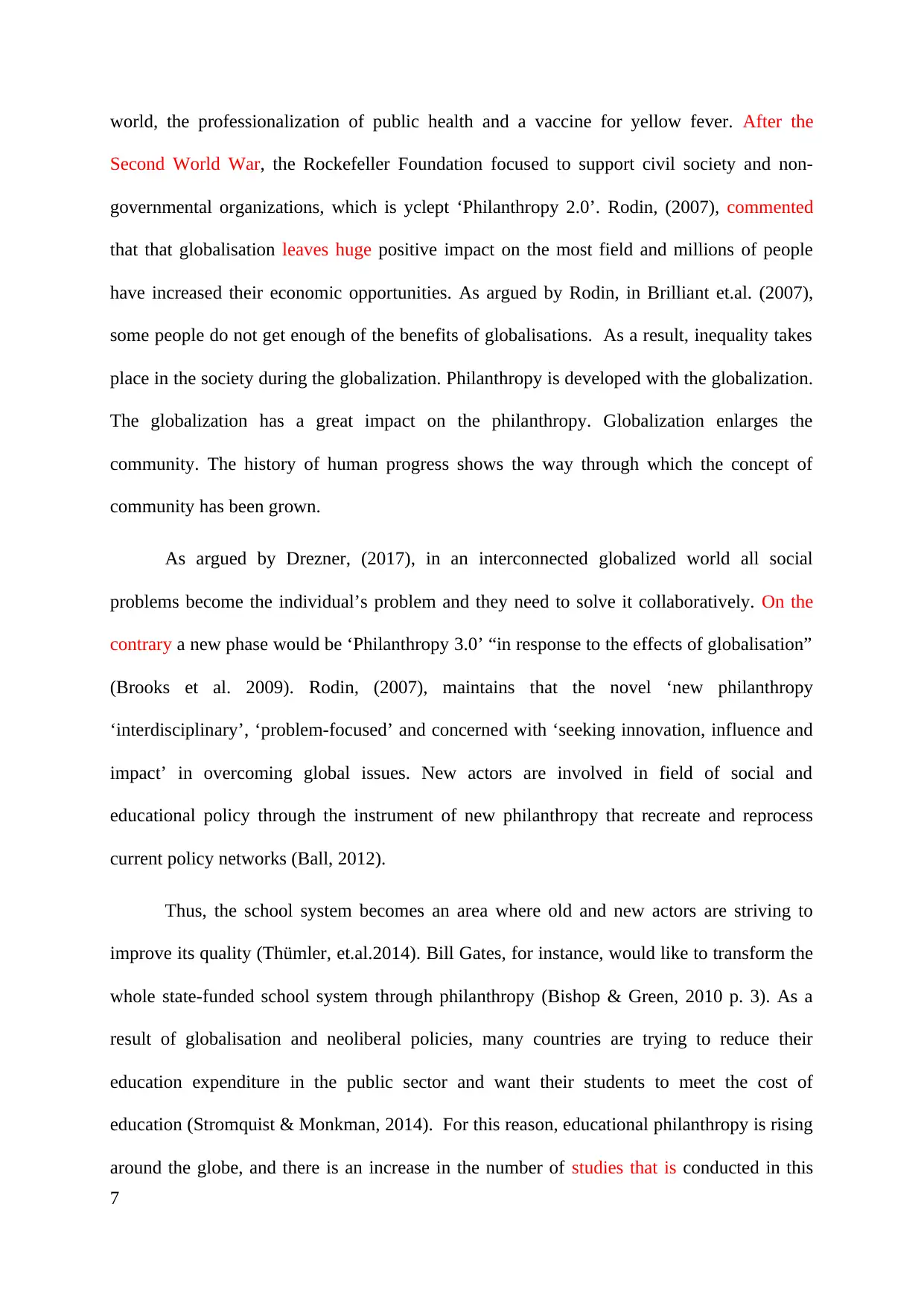
world, the professionalization of public health and a vaccine for yellow fever. After the
Second World War, the Rockefeller Foundation focused to support civil society and non-
governmental organizations, which is yclept ‘Philanthropy 2.0’. Rodin, (2007), commented
that that globalisation leaves huge positive impact on the most field and millions of people
have increased their economic opportunities. As argued by Rodin, in Brilliant et.al. (2007),
some people do not get enough of the benefits of globalisations. As a result, inequality takes
place in the society during the globalization. Philanthropy is developed with the globalization.
The globalization has a great impact on the philanthropy. Globalization enlarges the
community. The history of human progress shows the way through which the concept of
community has been grown.
As argued by Drezner, (2017), in an interconnected globalized world all social
problems become the individual’s problem and they need to solve it collaboratively. On the
contrary a new phase would be ‘Philanthropy 3.0’ “in response to the effects of globalisation”
(Brooks et al. 2009). Rodin, (2007), maintains that the novel ‘new philanthropy
‘interdisciplinary’, ‘problem-focused’ and concerned with ‘seeking innovation, influence and
impact’ in overcoming global issues. New actors are involved in field of social and
educational policy through the instrument of new philanthropy that recreate and reprocess
current policy networks (Ball, 2012).
Thus, the school system becomes an area where old and new actors are striving to
improve its quality (Thümler, et.al.2014). Bill Gates, for instance, would like to transform the
whole state-funded school system through philanthropy (Bishop & Green, 2010 p. 3). As a
result of globalisation and neoliberal policies, many countries are trying to reduce their
education expenditure in the public sector and want their students to meet the cost of
education (Stromquist & Monkman, 2014). For this reason, educational philanthropy is rising
around the globe, and there is an increase in the number of studies that is conducted in this
7
Second World War, the Rockefeller Foundation focused to support civil society and non-
governmental organizations, which is yclept ‘Philanthropy 2.0’. Rodin, (2007), commented
that that globalisation leaves huge positive impact on the most field and millions of people
have increased their economic opportunities. As argued by Rodin, in Brilliant et.al. (2007),
some people do not get enough of the benefits of globalisations. As a result, inequality takes
place in the society during the globalization. Philanthropy is developed with the globalization.
The globalization has a great impact on the philanthropy. Globalization enlarges the
community. The history of human progress shows the way through which the concept of
community has been grown.
As argued by Drezner, (2017), in an interconnected globalized world all social
problems become the individual’s problem and they need to solve it collaboratively. On the
contrary a new phase would be ‘Philanthropy 3.0’ “in response to the effects of globalisation”
(Brooks et al. 2009). Rodin, (2007), maintains that the novel ‘new philanthropy
‘interdisciplinary’, ‘problem-focused’ and concerned with ‘seeking innovation, influence and
impact’ in overcoming global issues. New actors are involved in field of social and
educational policy through the instrument of new philanthropy that recreate and reprocess
current policy networks (Ball, 2012).
Thus, the school system becomes an area where old and new actors are striving to
improve its quality (Thümler, et.al.2014). Bill Gates, for instance, would like to transform the
whole state-funded school system through philanthropy (Bishop & Green, 2010 p. 3). As a
result of globalisation and neoliberal policies, many countries are trying to reduce their
education expenditure in the public sector and want their students to meet the cost of
education (Stromquist & Monkman, 2014). For this reason, educational philanthropy is rising
around the globe, and there is an increase in the number of studies that is conducted in this
7
Paraphrase This Document
Need a fresh take? Get an instant paraphrase of this document with our AI Paraphraser
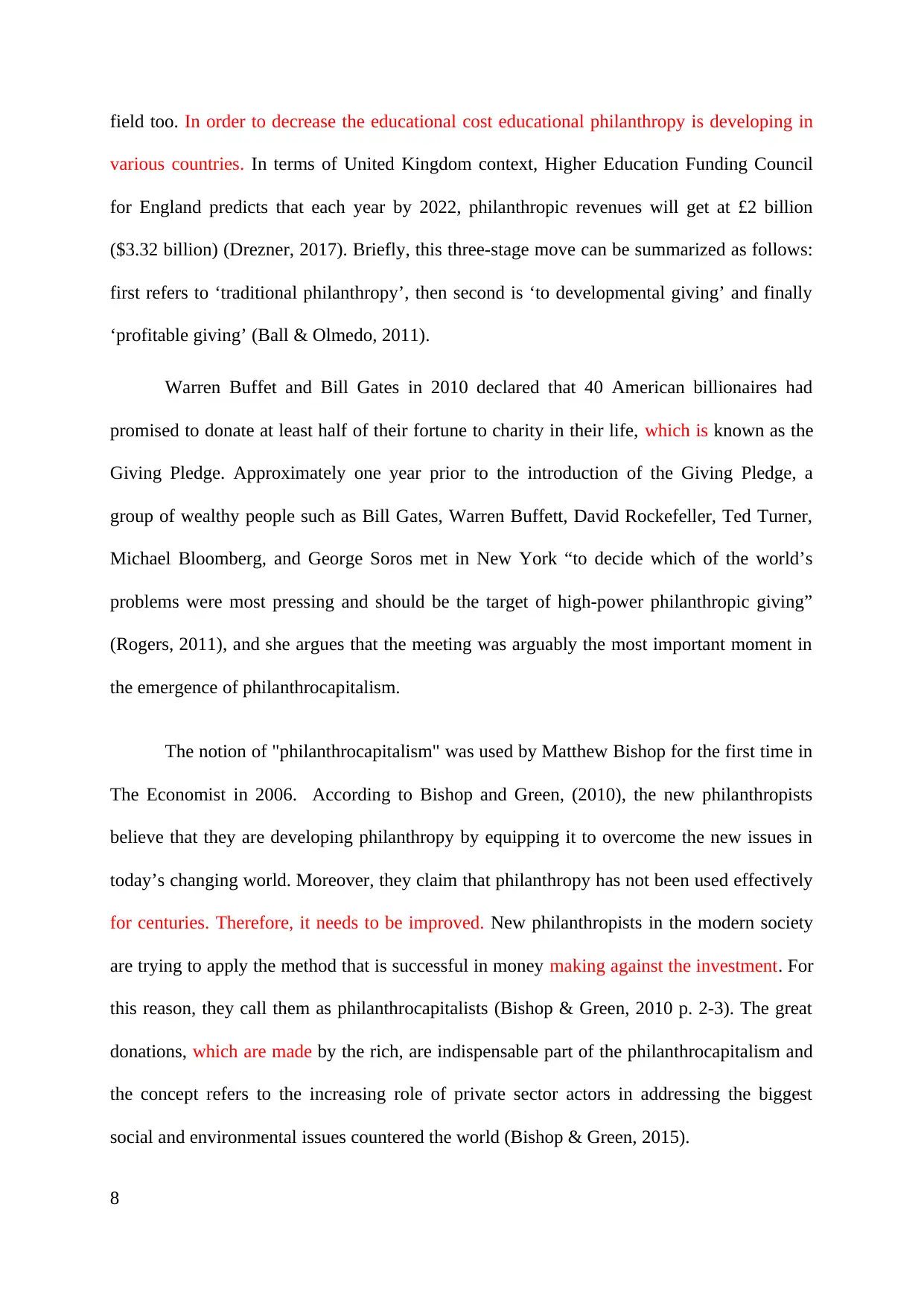
field too. In order to decrease the educational cost educational philanthropy is developing in
various countries. In terms of United Kingdom context, Higher Education Funding Council
for England predicts that each year by 2022, philanthropic revenues will get at £2 billion
($3.32 billion) (Drezner, 2017). Briefly, this three-stage move can be summarized as follows:
first refers to ‘traditional philanthropy’, then second is ‘to developmental giving’ and finally
‘profitable giving’ (Ball & Olmedo, 2011).
Warren Buffet and Bill Gates in 2010 declared that 40 American billionaires had
promised to donate at least half of their fortune to charity in their life, which is known as the
Giving Pledge. Approximately one year prior to the introduction of the Giving Pledge, a
group of wealthy people such as Bill Gates, Warren Buffett, David Rockefeller, Ted Turner,
Michael Bloomberg, and George Soros met in New York “to decide which of the world’s
problems were most pressing and should be the target of high-power philanthropic giving”
(Rogers, 2011), and she argues that the meeting was arguably the most important moment in
the emergence of philanthrocapitalism.
The notion of "philanthrocapitalism" was used by Matthew Bishop for the first time in
The Economist in 2006. According to Bishop and Green, (2010), the new philanthropists
believe that they are developing philanthropy by equipping it to overcome the new issues in
today’s changing world. Moreover, they claim that philanthropy has not been used effectively
for centuries. Therefore, it needs to be improved. New philanthropists in the modern society
are trying to apply the method that is successful in money making against the investment. For
this reason, they call them as philanthrocapitalists (Bishop & Green, 2010 p. 2-3). The great
donations, which are made by the rich, are indispensable part of the philanthrocapitalism and
the concept refers to the increasing role of private sector actors in addressing the biggest
social and environmental issues countered the world (Bishop & Green, 2015).
8
various countries. In terms of United Kingdom context, Higher Education Funding Council
for England predicts that each year by 2022, philanthropic revenues will get at £2 billion
($3.32 billion) (Drezner, 2017). Briefly, this three-stage move can be summarized as follows:
first refers to ‘traditional philanthropy’, then second is ‘to developmental giving’ and finally
‘profitable giving’ (Ball & Olmedo, 2011).
Warren Buffet and Bill Gates in 2010 declared that 40 American billionaires had
promised to donate at least half of their fortune to charity in their life, which is known as the
Giving Pledge. Approximately one year prior to the introduction of the Giving Pledge, a
group of wealthy people such as Bill Gates, Warren Buffett, David Rockefeller, Ted Turner,
Michael Bloomberg, and George Soros met in New York “to decide which of the world’s
problems were most pressing and should be the target of high-power philanthropic giving”
(Rogers, 2011), and she argues that the meeting was arguably the most important moment in
the emergence of philanthrocapitalism.
The notion of "philanthrocapitalism" was used by Matthew Bishop for the first time in
The Economist in 2006. According to Bishop and Green, (2010), the new philanthropists
believe that they are developing philanthropy by equipping it to overcome the new issues in
today’s changing world. Moreover, they claim that philanthropy has not been used effectively
for centuries. Therefore, it needs to be improved. New philanthropists in the modern society
are trying to apply the method that is successful in money making against the investment. For
this reason, they call them as philanthrocapitalists (Bishop & Green, 2010 p. 2-3). The great
donations, which are made by the rich, are indispensable part of the philanthrocapitalism and
the concept refers to the increasing role of private sector actors in addressing the biggest
social and environmental issues countered the world (Bishop & Green, 2015).
8
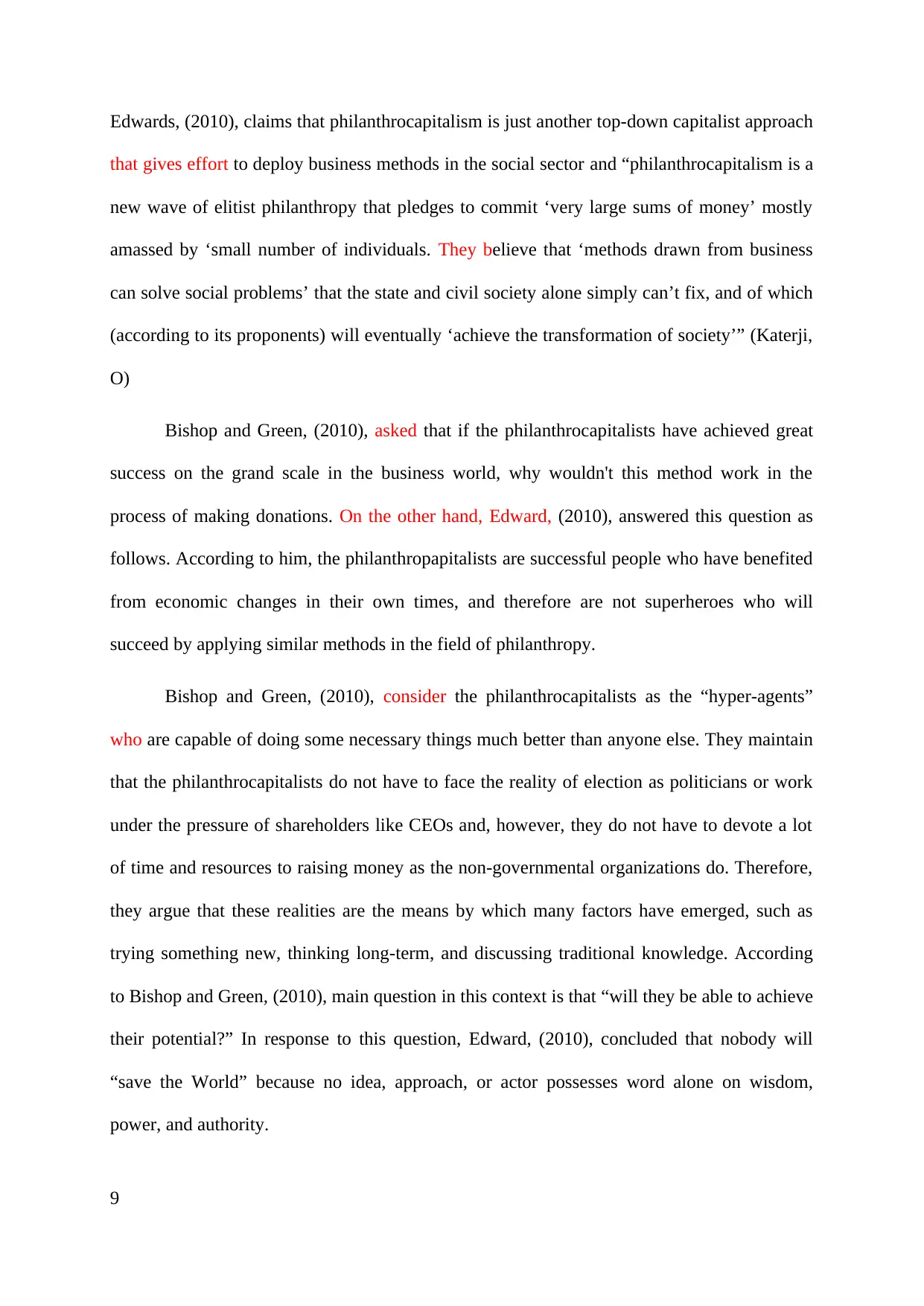
Edwards, (2010), claims that philanthrocapitalism is just another top-down capitalist approach
that gives effort to deploy business methods in the social sector and “philanthrocapitalism is a
new wave of elitist philanthropy that pledges to commit ‘very large sums of money’ mostly
amassed by ‘small number of individuals. They believe that ‘methods drawn from business
can solve social problems’ that the state and civil society alone simply can’t fix, and of which
(according to its proponents) will eventually ‘achieve the transformation of society’” (Katerji,
O)
Bishop and Green, (2010), asked that if the philanthrocapitalists have achieved great
success on the grand scale in the business world, why wouldn't this method work in the
process of making donations. On the other hand, Edward, (2010), answered this question as
follows. According to him, the philanthropapitalists are successful people who have benefited
from economic changes in their own times, and therefore are not superheroes who will
succeed by applying similar methods in the field of philanthropy.
Bishop and Green, (2010), consider the philanthrocapitalists as the “hyper-agents”
who are capable of doing some necessary things much better than anyone else. They maintain
that the philanthrocapitalists do not have to face the reality of election as politicians or work
under the pressure of shareholders like CEOs and, however, they do not have to devote a lot
of time and resources to raising money as the non-governmental organizations do. Therefore,
they argue that these realities are the means by which many factors have emerged, such as
trying something new, thinking long-term, and discussing traditional knowledge. According
to Bishop and Green, (2010), main question in this context is that “will they be able to achieve
their potential?” In response to this question, Edward, (2010), concluded that nobody will
“save the World” because no idea, approach, or actor possesses word alone on wisdom,
power, and authority.
9
that gives effort to deploy business methods in the social sector and “philanthrocapitalism is a
new wave of elitist philanthropy that pledges to commit ‘very large sums of money’ mostly
amassed by ‘small number of individuals. They believe that ‘methods drawn from business
can solve social problems’ that the state and civil society alone simply can’t fix, and of which
(according to its proponents) will eventually ‘achieve the transformation of society’” (Katerji,
O)
Bishop and Green, (2010), asked that if the philanthrocapitalists have achieved great
success on the grand scale in the business world, why wouldn't this method work in the
process of making donations. On the other hand, Edward, (2010), answered this question as
follows. According to him, the philanthropapitalists are successful people who have benefited
from economic changes in their own times, and therefore are not superheroes who will
succeed by applying similar methods in the field of philanthropy.
Bishop and Green, (2010), consider the philanthrocapitalists as the “hyper-agents”
who are capable of doing some necessary things much better than anyone else. They maintain
that the philanthrocapitalists do not have to face the reality of election as politicians or work
under the pressure of shareholders like CEOs and, however, they do not have to devote a lot
of time and resources to raising money as the non-governmental organizations do. Therefore,
they argue that these realities are the means by which many factors have emerged, such as
trying something new, thinking long-term, and discussing traditional knowledge. According
to Bishop and Green, (2010), main question in this context is that “will they be able to achieve
their potential?” In response to this question, Edward, (2010), concluded that nobody will
“save the World” because no idea, approach, or actor possesses word alone on wisdom,
power, and authority.
9
⊘ This is a preview!⊘
Do you want full access?
Subscribe today to unlock all pages.

Trusted by 1+ million students worldwide
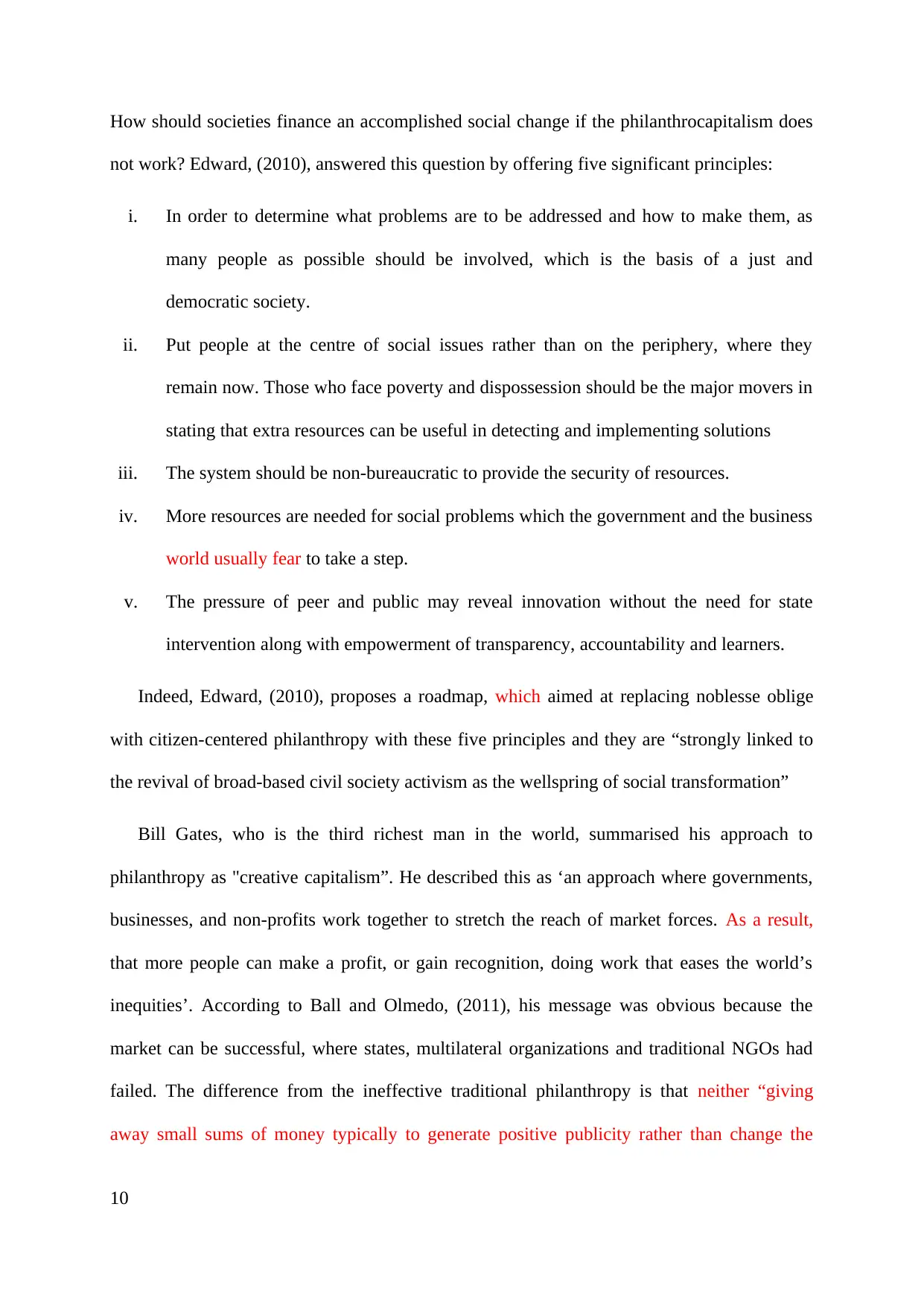
How should societies finance an accomplished social change if the philanthrocapitalism does
not work? Edward, (2010), answered this question by offering five significant principles:
i. In order to determine what problems are to be addressed and how to make them, as
many people as possible should be involved, which is the basis of a just and
democratic society.
ii. Put people at the centre of social issues rather than on the periphery, where they
remain now. Those who face poverty and dispossession should be the major movers in
stating that extra resources can be useful in detecting and implementing solutions
iii. The system should be non-bureaucratic to provide the security of resources.
iv. More resources are needed for social problems which the government and the business
world usually fear to take a step.
v. The pressure of peer and public may reveal innovation without the need for state
intervention along with empowerment of transparency, accountability and learners.
Indeed, Edward, (2010), proposes a roadmap, which aimed at replacing noblesse oblige
with citizen-centered philanthropy with these five principles and they are “strongly linked to
the revival of broad-based civil society activism as the wellspring of social transformation”
Bill Gates, who is the third richest man in the world, summarised his approach to
philanthropy as "creative capitalism”. He described this as ‘an approach where governments,
businesses, and non-profits work together to stretch the reach of market forces. As a result,
that more people can make a profit, or gain recognition, doing work that eases the world’s
inequities’. According to Ball and Olmedo, (2011), his message was obvious because the
market can be successful, where states, multilateral organizations and traditional NGOs had
failed. The difference from the ineffective traditional philanthropy is that neither “giving
away small sums of money typically to generate positive publicity rather than change the
10
not work? Edward, (2010), answered this question by offering five significant principles:
i. In order to determine what problems are to be addressed and how to make them, as
many people as possible should be involved, which is the basis of a just and
democratic society.
ii. Put people at the centre of social issues rather than on the periphery, where they
remain now. Those who face poverty and dispossession should be the major movers in
stating that extra resources can be useful in detecting and implementing solutions
iii. The system should be non-bureaucratic to provide the security of resources.
iv. More resources are needed for social problems which the government and the business
world usually fear to take a step.
v. The pressure of peer and public may reveal innovation without the need for state
intervention along with empowerment of transparency, accountability and learners.
Indeed, Edward, (2010), proposes a roadmap, which aimed at replacing noblesse oblige
with citizen-centered philanthropy with these five principles and they are “strongly linked to
the revival of broad-based civil society activism as the wellspring of social transformation”
Bill Gates, who is the third richest man in the world, summarised his approach to
philanthropy as "creative capitalism”. He described this as ‘an approach where governments,
businesses, and non-profits work together to stretch the reach of market forces. As a result,
that more people can make a profit, or gain recognition, doing work that eases the world’s
inequities’. According to Ball and Olmedo, (2011), his message was obvious because the
market can be successful, where states, multilateral organizations and traditional NGOs had
failed. The difference from the ineffective traditional philanthropy is that neither “giving
away small sums of money typically to generate positive publicity rather than change the
10
Paraphrase This Document
Need a fresh take? Get an instant paraphrase of this document with our AI Paraphraser
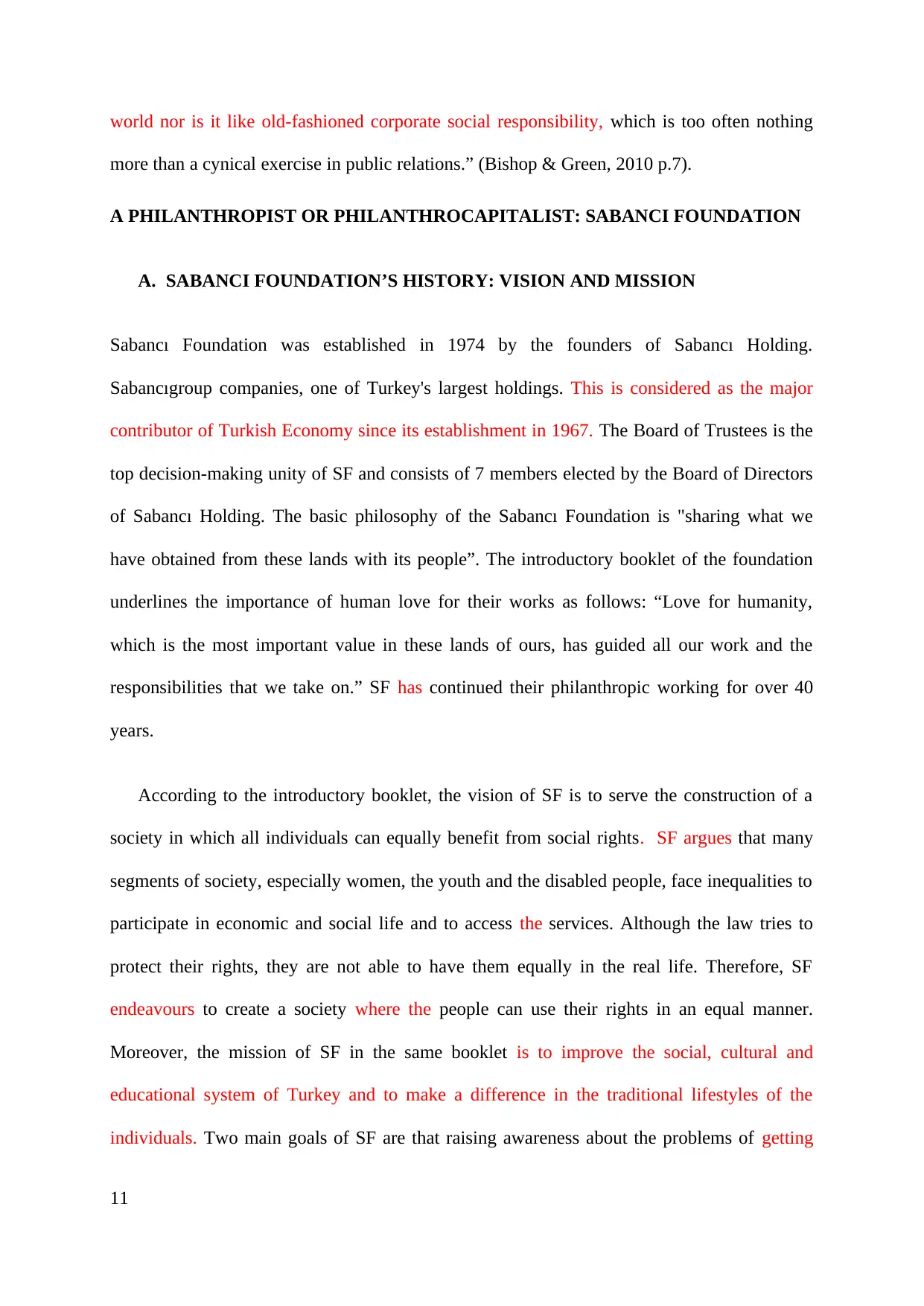
world nor is it like old-fashioned corporate social responsibility, which is too often nothing
more than a cynical exercise in public relations.” (Bishop & Green, 2010 p.7).
A PHILANTHROPIST OR PHILANTHROCAPITALIST: SABANCI FOUNDATION
A. SABANCI FOUNDATION’S HISTORY: VISION AND MISSION
Sabancı Foundation was established in 1974 by the founders of Sabancı Holding.
Sabancıgroup companies, one of Turkey's largest holdings. This is considered as the major
contributor of Turkish Economy since its establishment in 1967. The Board of Trustees is the
top decision-making unity of SF and consists of 7 members elected by the Board of Directors
of Sabancı Holding. The basic philosophy of the Sabancı Foundation is "sharing what we
have obtained from these lands with its people”. The introductory booklet of the foundation
underlines the importance of human love for their works as follows: “Love for humanity,
which is the most important value in these lands of ours, has guided all our work and the
responsibilities that we take on.” SF has continued their philanthropic working for over 40
years.
According to the introductory booklet, the vision of SF is to serve the construction of a
society in which all individuals can equally benefit from social rights. SF argues that many
segments of society, especially women, the youth and the disabled people, face inequalities to
participate in economic and social life and to access the services. Although the law tries to
protect their rights, they are not able to have them equally in the real life. Therefore, SF
endeavours to create a society where the people can use their rights in an equal manner.
Moreover, the mission of SF in the same booklet is to improve the social, cultural and
educational system of Turkey and to make a difference in the traditional lifestyles of the
individuals. Two main goals of SF are that raising awareness about the problems of getting
11
more than a cynical exercise in public relations.” (Bishop & Green, 2010 p.7).
A PHILANTHROPIST OR PHILANTHROCAPITALIST: SABANCI FOUNDATION
A. SABANCI FOUNDATION’S HISTORY: VISION AND MISSION
Sabancı Foundation was established in 1974 by the founders of Sabancı Holding.
Sabancıgroup companies, one of Turkey's largest holdings. This is considered as the major
contributor of Turkish Economy since its establishment in 1967. The Board of Trustees is the
top decision-making unity of SF and consists of 7 members elected by the Board of Directors
of Sabancı Holding. The basic philosophy of the Sabancı Foundation is "sharing what we
have obtained from these lands with its people”. The introductory booklet of the foundation
underlines the importance of human love for their works as follows: “Love for humanity,
which is the most important value in these lands of ours, has guided all our work and the
responsibilities that we take on.” SF has continued their philanthropic working for over 40
years.
According to the introductory booklet, the vision of SF is to serve the construction of a
society in which all individuals can equally benefit from social rights. SF argues that many
segments of society, especially women, the youth and the disabled people, face inequalities to
participate in economic and social life and to access the services. Although the law tries to
protect their rights, they are not able to have them equally in the real life. Therefore, SF
endeavours to create a society where the people can use their rights in an equal manner.
Moreover, the mission of SF in the same booklet is to improve the social, cultural and
educational system of Turkey and to make a difference in the traditional lifestyles of the
individuals. Two main goals of SF are that raising awareness about the problems of getting
11
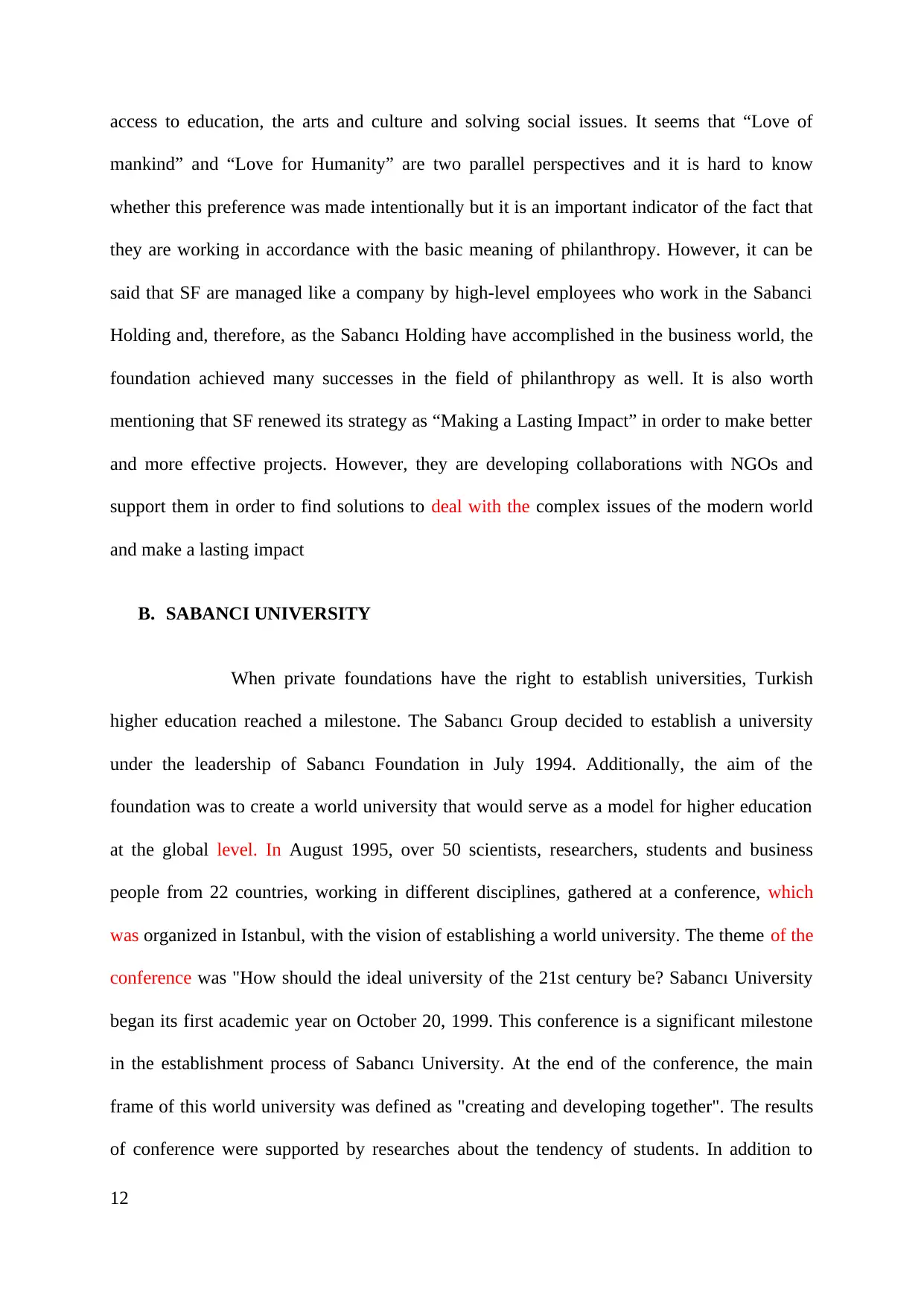
access to education, the arts and culture and solving social issues. It seems that “Love of
mankind” and “Love for Humanity” are two parallel perspectives and it is hard to know
whether this preference was made intentionally but it is an important indicator of the fact that
they are working in accordance with the basic meaning of philanthropy. However, it can be
said that SF are managed like a company by high-level employees who work in the Sabanci
Holding and, therefore, as the Sabancı Holding have accomplished in the business world, the
foundation achieved many successes in the field of philanthropy as well. It is also worth
mentioning that SF renewed its strategy as “Making a Lasting Impact” in order to make better
and more effective projects. However, they are developing collaborations with NGOs and
support them in order to find solutions to deal with the complex issues of the modern world
and make a lasting impact
B. SABANCI UNIVERSITY
When private foundations have the right to establish universities, Turkish
higher education reached a milestone. The Sabancı Group decided to establish a university
under the leadership of Sabancı Foundation in July 1994. Additionally, the aim of the
foundation was to create a world university that would serve as a model for higher education
at the global level. In August 1995, over 50 scientists, researchers, students and business
people from 22 countries, working in different disciplines, gathered at a conference, which
was organized in Istanbul, with the vision of establishing a world university. The theme of the
conference was "How should the ideal university of the 21st century be? Sabancı University
began its first academic year on October 20, 1999. This conference is a significant milestone
in the establishment process of Sabancı University. At the end of the conference, the main
frame of this world university was defined as "creating and developing together". The results
of conference were supported by researches about the tendency of students. In addition to
12
mankind” and “Love for Humanity” are two parallel perspectives and it is hard to know
whether this preference was made intentionally but it is an important indicator of the fact that
they are working in accordance with the basic meaning of philanthropy. However, it can be
said that SF are managed like a company by high-level employees who work in the Sabanci
Holding and, therefore, as the Sabancı Holding have accomplished in the business world, the
foundation achieved many successes in the field of philanthropy as well. It is also worth
mentioning that SF renewed its strategy as “Making a Lasting Impact” in order to make better
and more effective projects. However, they are developing collaborations with NGOs and
support them in order to find solutions to deal with the complex issues of the modern world
and make a lasting impact
B. SABANCI UNIVERSITY
When private foundations have the right to establish universities, Turkish
higher education reached a milestone. The Sabancı Group decided to establish a university
under the leadership of Sabancı Foundation in July 1994. Additionally, the aim of the
foundation was to create a world university that would serve as a model for higher education
at the global level. In August 1995, over 50 scientists, researchers, students and business
people from 22 countries, working in different disciplines, gathered at a conference, which
was organized in Istanbul, with the vision of establishing a world university. The theme of the
conference was "How should the ideal university of the 21st century be? Sabancı University
began its first academic year on October 20, 1999. This conference is a significant milestone
in the establishment process of Sabancı University. At the end of the conference, the main
frame of this world university was defined as "creating and developing together". The results
of conference were supported by researches about the tendency of students. In addition to
12
⊘ This is a preview!⊘
Do you want full access?
Subscribe today to unlock all pages.

Trusted by 1+ million students worldwide
1 out of 19
Your All-in-One AI-Powered Toolkit for Academic Success.
+13062052269
info@desklib.com
Available 24*7 on WhatsApp / Email
![[object Object]](/_next/static/media/star-bottom.7253800d.svg)
Unlock your academic potential
Copyright © 2020–2025 A2Z Services. All Rights Reserved. Developed and managed by ZUCOL.